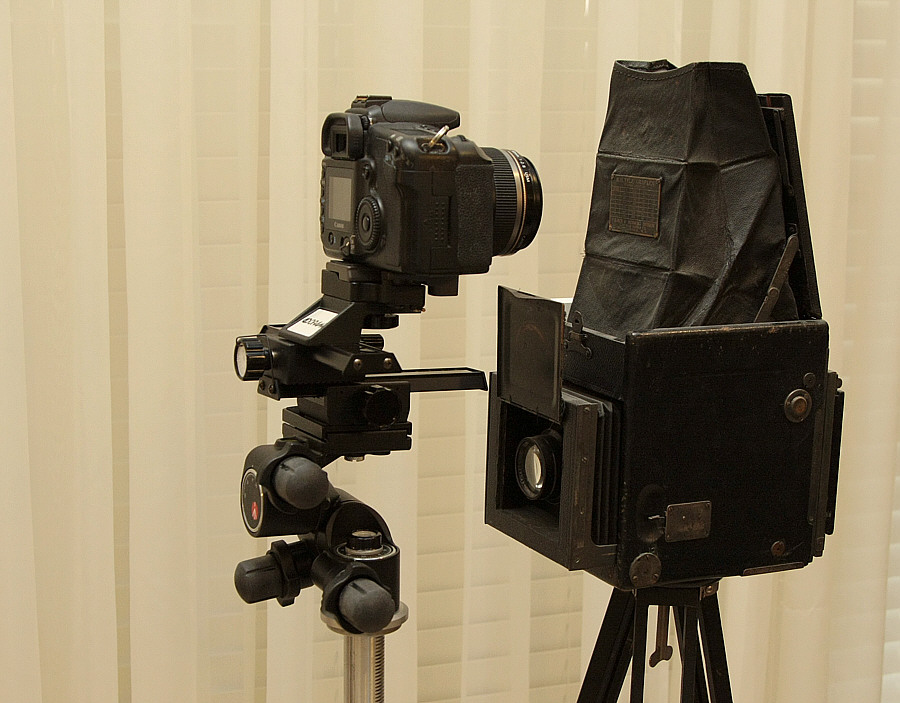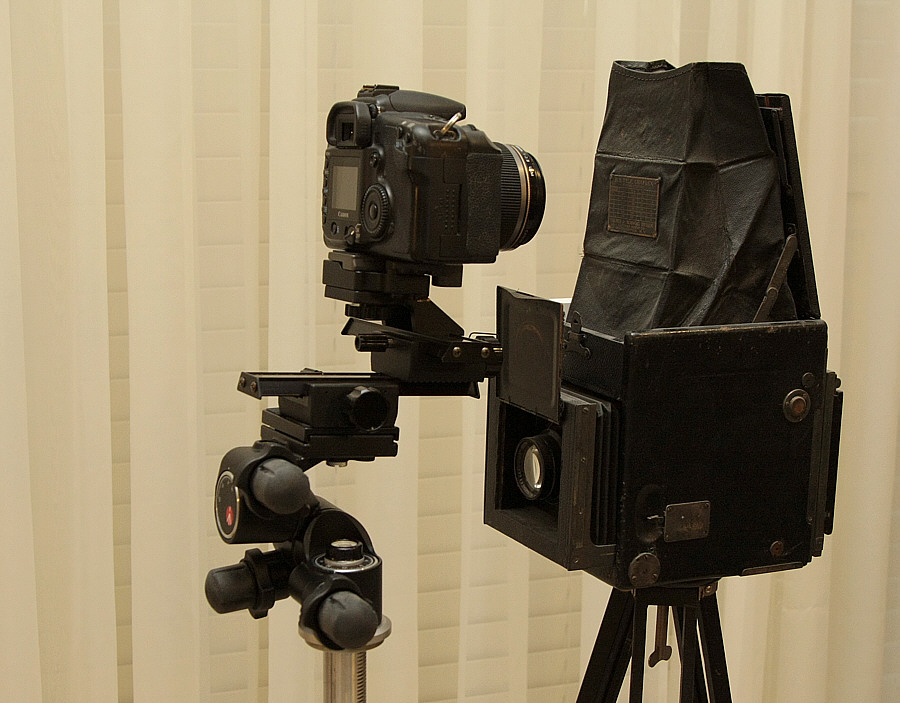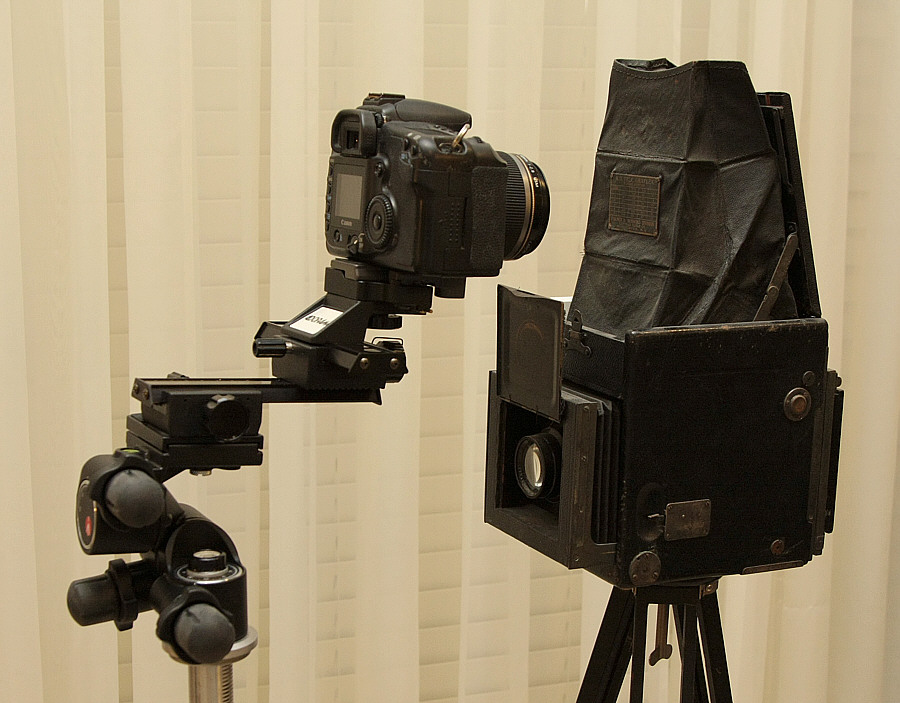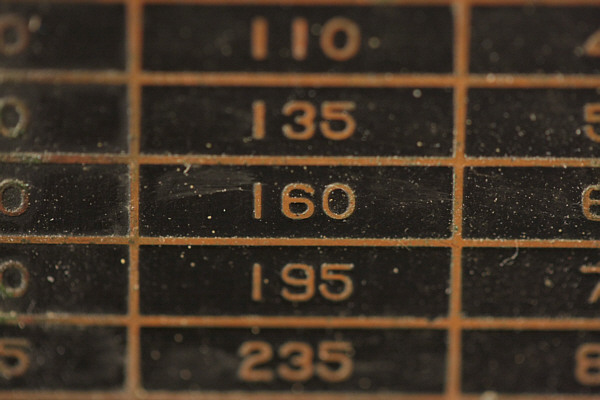Doug Kerr
Well-known member
Bush-league panoramic work with the Manfrotto 410
Those who are intersted in experimenting with multi-image panoramic photography but are not yet ready to spring for a genuine panoramic head setup (we'll see a picture of a nice one later), but who have a Manfrotto 410 (or 405) geared head will find that, in some situations, quite practical panoramic work can be done with it alone (and even better with the addition of a two-axis macro focusing rail).
If our situation involves only "far-field" objects (as in much true landscape panoramic work), and thus we can essentially ignore the matter of parallax caused by use of an inappropriate axis of rotation, the 410 or 405 head can be used alone.
Indexing between shots can be readily done using the yaw angle movement. On the 410, one "tooth position" (when we have released the worm) corresponds to an increment of 7.2° (precisely 1/50 of a circle). On the 405, the increment is about 6.545° (precisely 1/55 of a circle - go figure).
Any desired incremental angle can be easily attained by counting turns of the knob (or even fractions - on the 410, the knob has four flutes around its perimeter, handy for that).
For multi-row panoramic arrays, the pitch angle movement has the same setup.
If our scene will include "near-field" elements, so that we must be concerned with parallax, a convenient accessory to the 410 or 405 head is a two-axis macro focusing rail (such as the Adorama model you may have seen earlier in this series). We see this setup here (with a 410):
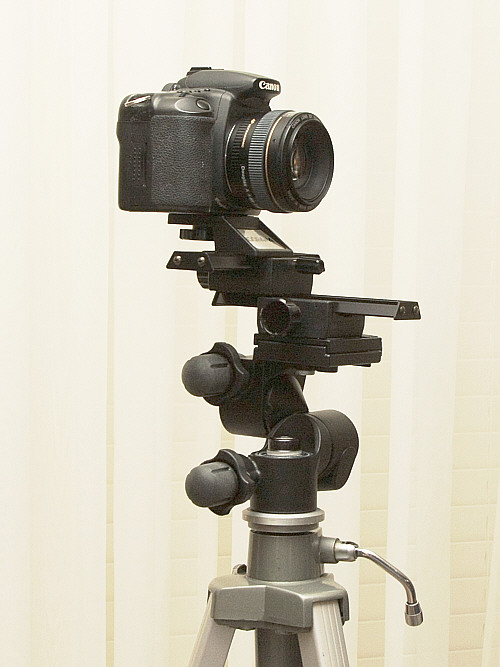
The lateral movement of the rail allows us to get the lens axis over the yaw angle axis of the head. The longitudinal ("focusing") movement allows us to get the entrance pupil of the lens over the yaw angle axis of the head, with this caveat:
Unlike the situation with a bona fide panoramic head, in this rig, the pitch angle axis does not pass through the lens axis (it is about 7" "below"). Thus, the ideal pivot situation for single-row panoramas (regarding the location of the entrance pupil) is disrupted by pitch angle movement. That means that precise adjustment of the longitudinal slide needs to be made after the pitch attitude to be used is determined and set. And for multi-row images, rigorous maintenance of the ideal panoramic axis is impractical.
As I suggested earlier, these difficulties may be of little or no practical importance unless there are near-field objects in the scene.
Those who carefully look for anomalies in pictures (aha! note the prop department item sticker on the bottom of that Western Electric 500D telephone set!) may note that the Adorama rail in the picture above is configured differently than in the prior picture. There are four ways this rig can be assembled, so as to make the camera platform extend either "inboard" or "outboard", and to control which side the "focusing" knob lies (on one side or another, it may interfere with whatever is below).
I normally keep mine in a configuration different from "factory". For this setup, I had to use a different "non-factory" configuration yet.
The reconfiguration is easily done.
For clarity, in this picture, the camera was mounted directly to the camera platform of the Adorama rail unit (no quick disconnect rig being used there - I normally have a Manfrotto "RC2-style" quick disconnect assembly there).
The careful observer may also note, atop the yaw angle axis scale plate, a small circular spirit level (an addition here). It allows me to be certain that the head "base" is level. (The Manfrotto 405 has such built in.)
By the way, for fanciers of the Adorama two-axis rail (an admirable item, in my estimation), I note that the price has now risen to $179.95. Adorama now carries a "lite/budget" version, at a price of $79.95. I don't know anything about it, except that from the pictures it seems to have about the same configuration.
Now, before whoever it is here that always tells me "you can't be a professional photographer without professional equipment" (and I certainly do not pose as a professional photographer, so I'm not sure of his point) get his knickers in a twist (that's the golfing pants), lets look at a real panoramic head, the Really Right Stuff "full boat":

This in fact allows us to arrange for both yaw angle and pitch angle axes to pass through the entrance pupil of the lens (or through the camera serial number plate, if we heard somewhere that's where they ought to go).
As seen in the picture, the "list" price of that rig is about $955. It looks really nice.
Now if you had one of those, plus a Manfrotto 410, plus an Adorama two-axis rail, plus a really nice tripod, you'd be ready for a lot of different projects.
Best regards,
Doug
Those who are intersted in experimenting with multi-image panoramic photography but are not yet ready to spring for a genuine panoramic head setup (we'll see a picture of a nice one later), but who have a Manfrotto 410 (or 405) geared head will find that, in some situations, quite practical panoramic work can be done with it alone (and even better with the addition of a two-axis macro focusing rail).
If our situation involves only "far-field" objects (as in much true landscape panoramic work), and thus we can essentially ignore the matter of parallax caused by use of an inappropriate axis of rotation, the 410 or 405 head can be used alone.
Indexing between shots can be readily done using the yaw angle movement. On the 410, one "tooth position" (when we have released the worm) corresponds to an increment of 7.2° (precisely 1/50 of a circle). On the 405, the increment is about 6.545° (precisely 1/55 of a circle - go figure).
Any desired incremental angle can be easily attained by counting turns of the knob (or even fractions - on the 410, the knob has four flutes around its perimeter, handy for that).
For multi-row panoramic arrays, the pitch angle movement has the same setup.
If our scene will include "near-field" elements, so that we must be concerned with parallax, a convenient accessory to the 410 or 405 head is a two-axis macro focusing rail (such as the Adorama model you may have seen earlier in this series). We see this setup here (with a 410):

The lateral movement of the rail allows us to get the lens axis over the yaw angle axis of the head. The longitudinal ("focusing") movement allows us to get the entrance pupil of the lens over the yaw angle axis of the head, with this caveat:
Unlike the situation with a bona fide panoramic head, in this rig, the pitch angle axis does not pass through the lens axis (it is about 7" "below"). Thus, the ideal pivot situation for single-row panoramas (regarding the location of the entrance pupil) is disrupted by pitch angle movement. That means that precise adjustment of the longitudinal slide needs to be made after the pitch attitude to be used is determined and set. And for multi-row images, rigorous maintenance of the ideal panoramic axis is impractical.
As I suggested earlier, these difficulties may be of little or no practical importance unless there are near-field objects in the scene.
Those who carefully look for anomalies in pictures (aha! note the prop department item sticker on the bottom of that Western Electric 500D telephone set!) may note that the Adorama rail in the picture above is configured differently than in the prior picture. There are four ways this rig can be assembled, so as to make the camera platform extend either "inboard" or "outboard", and to control which side the "focusing" knob lies (on one side or another, it may interfere with whatever is below).
I normally keep mine in a configuration different from "factory". For this setup, I had to use a different "non-factory" configuration yet.
The reconfiguration is easily done.
For clarity, in this picture, the camera was mounted directly to the camera platform of the Adorama rail unit (no quick disconnect rig being used there - I normally have a Manfrotto "RC2-style" quick disconnect assembly there).
The careful observer may also note, atop the yaw angle axis scale plate, a small circular spirit level (an addition here). It allows me to be certain that the head "base" is level. (The Manfrotto 405 has such built in.)
By the way, for fanciers of the Adorama two-axis rail (an admirable item, in my estimation), I note that the price has now risen to $179.95. Adorama now carries a "lite/budget" version, at a price of $79.95. I don't know anything about it, except that from the pictures it seems to have about the same configuration.
Now, before whoever it is here that always tells me "you can't be a professional photographer without professional equipment" (and I certainly do not pose as a professional photographer, so I'm not sure of his point) get his knickers in a twist (that's the golfing pants), lets look at a real panoramic head, the Really Right Stuff "full boat":

This in fact allows us to arrange for both yaw angle and pitch angle axes to pass through the entrance pupil of the lens (or through the camera serial number plate, if we heard somewhere that's where they ought to go).
As seen in the picture, the "list" price of that rig is about $955. It looks really nice.
Now if you had one of those, plus a Manfrotto 410, plus an Adorama two-axis rail, plus a really nice tripod, you'd be ready for a lot of different projects.
Best regards,
Doug

